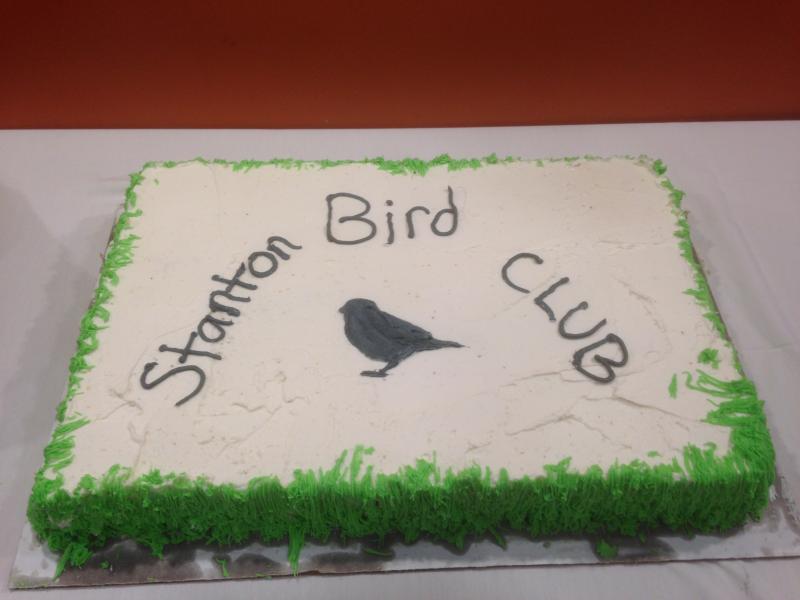We had the pleasure to give the keynote presentation at the annual meeting of the Stanton Bird Club in Lewiston last week on our new book, Birds of Aruba, Bonaire and Curaçao. We knew the Stanton Bird Club had been around for a long time but still it was a delightful surprise to learn that its 100-year anniversary is coming up in 2019. We also knew that the club has owned and managed the Thorncrag Bird Sanctuary—now a 327-acre preserve—in Lewiston since the 1920s. We didn’t know that the club also owns and manages a 400-acre preserve in Monmouth called the Woodbury Bird Sanctuary. And for some reason we had never pondered closely the fact that the club was named the “Stanton” Bird Club. The name, we now know, comes from a beloved Bates Latin and Greek professor name Jonathon Stanton who was an avid bird enthusiast who had died the year before the club was formed.
Small, locally run organizations like the Stanton Bird Club have always served a critically important role across Maine and the nation for conservation of birds and all aspects of the environment upon which people depend. Bird clubs and Audubon chapters were a key part of our lives as young people. We learned there about birds and other aspects of the natural world and saw, too, the enjoyment, social connections, and commitment of those who shared a love of birds and nature.
The year 1919 must have been a good one for birds because another bird club started in central Maine that year in Augusta. At that time, it was called the Ball Bird Club, after a Reverend Dwight Ball about whom we have not found any more history at the time of this writing. The club was renamed the Augusta Nature Club in 1928 and remains under that name today. Like the Stanton Bird Club, the Augusta Nature Club owns and manages a preserve in the city of Augusta. One of us (Allison) has fond memories of birding with one of the Augusta Nature Club’s most active members at the time, Marilyn Mollicone, who volunteered to take out students of Jim Miller’s Winthrop high school eco-ornithology class.
Not to be outdone, a club was founded in Bangor sometime before 1922 called the Bangor Bird Conservation Club. We haven’t been able to track down the full history yet, but we wonder if this might have been the predecessor of what is now known as the Bangor Nature Club, which has been around since at least 1945. The other of us (Jeff) attended many a meeting and field trip of the Bangor Nature Club while a youngster back in the 1970s and 1980s, greatly encouraged and mentored by its members, especially its president at the time, Inez Boyd.
Maine’s rich history of bird and nature organizations dates back to the founding of the Portland Museum of Natural History in 1843 and the establishment of what was first called The United Ornithologists’ of Maine in 1893. The latter group had its first annual meeting in 1896 in the old high school in Gardiner, and the next year changed the name to the Maine Ornithological Society. The same folks that were part of these organizations were instrumental in supporting the early National Audubon movement in Maine. In fact, by 1922 Maine had 51 Junior Audubon Clubs with over 1,400 youth participants, and 6 of the 17 Audubon wardens in the U.S. were stationed on Maine nesting seabird islands. Apparently, all of this bird enthusiasm was one of the reasons why then-Governor Percival Baxter set aside April 14, 1922 as Bird Day in Maine!
Amazingly, not only do we still have our original bird and nature clubs in Maine but we also have seven local Audubon chapters (at least one is more than 70 years old!), each with its own local volunteers educating kids about birds and nature and advocating for conservation.
Jeffrey V. Wells, Ph.D., is a Fellow of the Cornell Lab of Ornithology. Dr. Wells is one of the nation's leading bird experts and conservation biologists and author of the “Birder’s Conservation Handbook.” His grandfather, the late John Chase, was a columnist for the Boothbay Register for many years. Allison Childs Wells, formerly of the Cornell Lab of Ornithology, is a senior director at the Natural Resources Council of Maine, a nonprofit membership organization working statewide to protect the nature of Maine. Both are widely published natural history writers and are the authors of the book, “Maine’s Favorite Birds” and the just-released “Birds of Aruba, Bonaire, and Curaçao.”





























